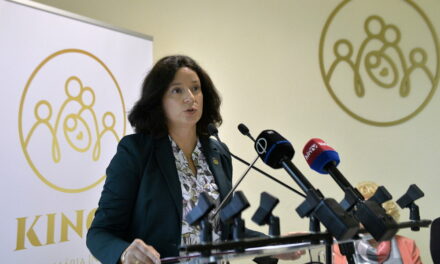The 1,000-square-meter, interactive permanent exhibition of the House of Hungarian Music will soon be ready, which will offer visitors an almost cinematic experience at the music initiation institution built in the Liget Budapest project, which will open at the beginning of 2022, music historian András Batta, managing director of the House of Hungarian Music, told MTI .
Teaching with fun
In the past, the question of why there is a need for another concert hall in Budapest was often raised. The answer is simple: hosting concerts will be just one part of the Hungarian House of Music's three tasks – museum, performing arts and education and dissemination – stressed András Batta.
The house will be opened as a music initiation and educational institution, its main vocation will be to address children, students, families and those adults who would like to get to know the world of music more deeply. The essence of the activity of the Hungarian Music House is teaching through entertainment, he emphasized.
According to András Batta, the triple function of the institution, which was built in the middle of Városliget, in a brown field investment, is well separated spatially: the concert halls are on the park level, the exhibition spaces that do not require natural light are built underground, and the music pedagogy and research rooms are on the upper floor, the building is almost are located in the floating roof.
"The building is characterized by a kind of 3V division: the permanent exhibition below the ground floor is a space of magic, where the visitor falls into a magical world. The community and event space on the ground floor is the space of reality, as it is where visitors meet live music and each other, but also the outside world, as thanks to the huge, several-story high glass surfaces, they can feel like they are in the Grove inside the building. And the first floor is a space of light, where the light pours in through the light wells lined with golden covering. From here, the student groups will also go to the Magic Square to discover the exhibition," the manager introduced the building.
Final touches
András Batta said that the final touches are being made to the building designed by the world-famous Japanese architect, Su Fujimoto, before the opening at the beginning of next year: both concert halls are practically ready, now the biggest work is going on in the Váráztér. Currently, the team of the German company that created the sound design is installing the sound sensors in the exhibition and the technical equipment is now being brought into the Sound Tower.
Installation of the installations has also begun. For example, the Code Gate, which introduces you to the world of the Gregorian calendar, is already in place, as well as the rotating Wheel of the Year, which parallels popular and ecclesiastical significant days.
The permanent exhibition titled Sound Dimensions – Musical Journeys in Space and Time is like a labyrinth. Visitors put on the headphones and from then on they can immerse themselves in the music: during their walk, they can listen to almost three hundred pieces of music from the past two millennia, in excellent sound quality, the manager said.
A virtual walk through seven experience points
As he said, the audience walks through the history of European and Hungarian music through seven experience points, falling into a kind of virtual reality. The journey begins with magic, the birth of music, where the visitor enters a forest, followed by the folk music square, which shows how music was an integral part of village life, from lullabies to dirges.
The next part is about ceremonies, where the path from Gregorian chant to the development of polyphony leads through church interiors, followed by a unit showing the birth of opera, which revolves around the musical expression of passion and suffering. The exhibition presents the outstanding musical life of the great royal residence of the 18th century Europe, and a separate area is also dedicated to the great classics, Bach, Haydn, Mozart and Beethoven.
This is followed by the "Hungarian chapter", which highlights the creation of the Hungarian national opera with Ferenc Erkel and where Liszt can also be heard playing the piano, and then the unit entitled "From the Phonograph to the Cloud" follows the evolution of sound technology throughout the 20th century to the present day. This includes Bartók and Kodály, the avant-garde experimental composers, the many shades of film music and then light music.
"At the end of the road, we reach another forest, which is the forest of all the music that surrounds us, since today we can listen to almost any music anywhere," said András Batta.
As he pointed out, the exhibition can be walked through interactively, with the help of space-based headphones. Audio-visual experiences are accompanied by a creative sound space, where not only traditional instruments can be tried out, but also those who have no musical experience can study pitches, timbres and rhythm with various "musical toys". In addition, a musical playground will be built next to the House of Hungarian Music, where there will also be a lot of musical games, he noted.
András Batta singled out the Hangdóm featured in the exhibition, as there is no other structure of this size in the world with constant operation. The interior surface of the Sound Dome, shaped like a dome or a bell, can be projected 360 degrees with eight projectors, and thirty-one speakers are responsible for the perfect sound effect. The sight and the almost physically perceptible sound give a special experience at the same time, he said.
In addition to the permanent exhibition, the public will also be treated to temporary exhibitions; the first opens in the spring and covers the history of Hungarian popular music from 1957 until the regime change.
The concert program for the first semester of the event space on the ground floor has already been prepared, and the concept of many educational programs in the house, from children's programs to the free university, which will also be characterized by interactivity and, of course, a lot of live music, said András Batta.
MTI
Photo: music historian András Batta, managing director of the House of Hungarian Music, at the House of Hungarian Music being built as part of the Liget Budapest project on November 22, 2021.
The 1,000-square-meter, interactive permanent exhibition of the House of Hungarian Music will soon be completed in the institution, which will open in early 2022. MTI/Márton Mónus












